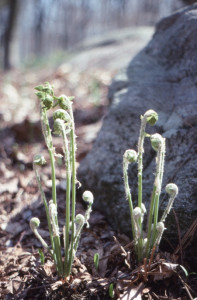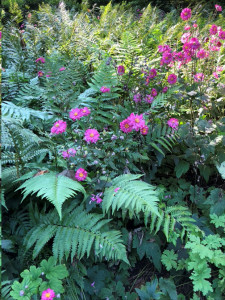General Introduction to Hardy Ferns©
by Mobee Weinstein

With their fabulous foliage, ferns are an essential part of any shade garden. Being low maintenance, easy care plants is a bonus for novice and experienced gardeners alike. For most species, providing an organic well-drained soil kept moist and some shade from hot afternoon sun is all you need. Fortunately, most ferns are rarely bothered by pests. What a relief to not have to worry about rabbits and deer! The emergence of fiddleheads (new fern leaves) in spring is an exciting and wonderful sign of rebirth. Each species has its own characteristic “creature-like” look as they unfurl and come back to life. It’s alive! It is at the very beginning of this stage that you can harvest fiddleheads from our native ostrich fern and cook up a little gourmet treat. Go ahead and grow your own! And don’t forget to plant some evergreen ferns to provide winter interest when winter rolls around again.

Very diverse, ferns exhibit an abundant display of variation in their size, overall form and texture. From low growing, evergreen mounds to large vertical specimens. Their fronds (aka leaves) can be lacy and delicate or lustrous and leathery. Masters of the color green, you can find them ranging from a deep, dark green to a light apple green and every shade in between, providing just the right complement to their planted neighbors. And if that’s not enough, some ferns also offer even more color adding silvery gray, burgundy, red and bronze into the mix. All of these captivating qualities combine to create timeless beauty. Humans have been enamored with the allure ferns for centuries. Fern motifs were used in primitive artwork, but became most famous during Victorian times in the mid 1800’s, and are ever present in today’s modern world, gracing architectural features and all kinds of interior and exterior décor. The Japanese painted fern (Athyrium niponicum ‘Pictum’) was chosen as the Perennial Plant of the Year 2004.

Designing with ferns is fun and easy. Their versatility can contribute to naturalistic styled plantings, formal designs, mixed gardens or virtually anything you can conceive of. Ferns play well with other companion plants or work perfectly on their own. If you are looking to cover large areas (a groundcover of sorts) there are ferns that will, in time, colonize an area. Look for types that are spreading or “wide creeping”. These ferns would most typically be used in a naturalistic garden or area. Conversely, there are ferns that grow as a single clump. These can be massed together for a larger effect, but they can also be used individually as specimens or in small groups helping to create a focal point. These types of ferns work perfectly in a naturalistic setting but also fit very nicely into a more formal design scheme.

Native or not? There are over 100 species of ferns native to northeastern North America. If you are looking to use native plants, you should have no trouble finding them. A dozen or so fern species are often readily available. Native plants are well adapted to our environment and therefore make excellent choices. Sustainable and organic gardening practices support growing native species. Having said that, our native ferns have many close relatives growing in Europe and Asia, often sharing very similar growing environments. Many of these species are equally at home here in the US and are very well behaved. Additionally, a number of them make great garden plants. You’re not likely to do harm incorporating a few of them into your garden plan.
No garden is complete without some frondly ferns. ☺
Welcome to the wonderful world of ferns!
About the author: Mobee Weinstein is a horticulturist and past president of the New York Chapter of the American Fern Society. She has been published several times and most recently authored “The Complete Book of Ferns” Cool Springs Press 2020.
Photos courtesy of Mobee Weinstein.